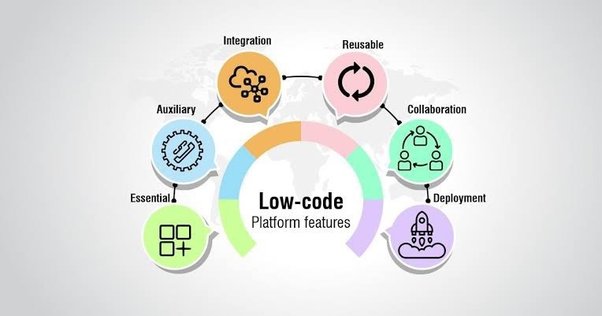Coding Simplified: The Creation of Low-Code Platform for Application Development

In today’s fast-paced digital world, the demand for innovative applications is ever-growing. However, traditional software development methods often pose challenges in terms of time, resources, and expertise required. This is where low-code platforms come into play, revolutionizing the way applications are built and deployed. This article explores the concept of coding simplified through the lens of low-code platforms, delving into their evolution, benefits, key features, development process, challenges, and real-world examples.
Introduction to Low-Code Platform
Low-code platforms are visual development environments that enable users to create applications with minimal hand-coding and maximum efficiency. These platforms leverage intuitive interfaces, drag-and-drop functionality, and pre-built components to streamline the development process.
Understanding the Need for Simplification in Coding
Traditional coding methods often involve lengthy processes, complex syntax, and steep learning curves, making it challenging for businesses to keep up with the pace of technological advancements. Low-code platforms address this need for simplification by abstracting away much of the coding complexity, allowing users to focus on application logic and functionality.
Evolution of Low-Code Platforms
Low-code platforms have evolved significantly over the years, transitioning from basic form builders to comprehensive application development suites. Early adopters faced limitations in terms of customization and scalability, but advancements in technology have overcome many of these barriers, making low-code platform for application development viable options for a wide range of use cases.
Benefits of Low-Code Platforms
Accelerated Development Process
One of the primary advantages of low-code platforms is the accelerated development process they offer. By eliminating the need for manual coding and providing reusable components, developers can build applications in a fraction of the time it would take using traditional methods.
Reduced Dependency on Highly Skilled Developers
Low-code platforms empower citizen developers, individuals with limited coding experience, to participate in the application development process. This reduces the burden on highly skilled developers and enables organizations to leverage a broader talent pool.
Enhanced Collaboration
The visual nature of low-code platforms facilitates collaboration between business stakeholders and development teams. By providing a common language for discussing requirements and prototypes, these platforms promote alignment and accelerate the feedback loop.
Key Features of Low-Code Platforms
Drag-and-Drop Interface
Low-code platforms typically feature drag-and-drop interfaces, allowing users to design application interfaces and workflows visually. This intuitive approach enables rapid prototyping and iteration, minimizing the need for manual coding.
Visual Modeling Tools
Many low-code platforms include visual modeling tools for defining data models, business processes, and user interactions. These tools abstract away the underlying complexity, making it easier for users to understand and modify application logic.
Pre-built Templates and Components
Low-code platforms often come with a library of pre-built templates and components, covering common use cases such as user authentication, data integration, and reporting. These ready-made assets accelerate development and ensure consistency across applications.
The Process of Creating Applications with Low-Code Platforms
Choosing the Right Platform
The first step in creating applications with an Enterprise application development platform is selecting the right platform for your needs. Consider factors such as ease of use, scalability, integration capabilities, and vendor support.
Designing the Application
Once a platform has been chosen, the next step is designing the application’s user interface and workflow. Use the platform’s visual design tools to create wireframes and prototypes that capture the intended user experience.
Configuring Business Logic
With the application design in place, focus on configuring the business logic that drives its behavior. Use visual modeling tools to define data models, workflows, and rules that govern how the application functions.
Integrating with External Systems
Many applications require integration with external systems such as databases, APIs, and third-party services. Low-code platforms typically offer connectors and integration tools to simplify this process, allowing you to seamlessly connect your application to other systems.
Overcoming Challenges in Low-Code Development
While low-code platforms offer many benefits, they also pose certain challenges that developers must address:
Customization Limitations
Some low-code platforms have limitations in terms of customization, particularly for complex or unique use cases. Developers may need to find workarounds or supplement the platform with custom code to achieve their desired functionality.
Security Concerns
Security is a critical consideration in low-code development, as the visual nature of these platforms can sometimes lead to oversight or misconfiguration of security controls. Developers should follow best practices for secure coding and regularly audit their applications for vulnerabilities.
Scalability Issues
As applications built on low-code platforms grow in complexity and user base, scalability can become a concern. Developers should design applications with scalability in mind, leveraging cloud infrastructure and distributed architectures where appropriate.
Real-world Examples of Successful Applications Built on Low-Code Platforms
Customer Relationship Management (CRM) Systems
Many organizations use low-code platforms to build custom CRM systems tailored to their specific needs. These systems enable sales teams to track leads, manage contacts, and analyze customer interactions more efficiently.
Workflow Automation Tools
Low-code platforms are ideal for building workflow automation tools that streamline repetitive tasks and processes. These tools help organizations improve efficiency, reduce errors, and enhance collaboration across teams.
Conclusion
In conclusion, low-code platforms represent a paradigm shift in application development, offering a faster, more accessible, and collaborative approach to building software. By simplifying the coding process and empowering citizen developers, these platforms unlock new opportunities for innovation and digital transformation.
FAQs
Is coding experience required to use low-code platforms?
While coding experience can be beneficial, many low-code platforms are designed to be user-friendly and accessible to individuals with limited technical knowledge.
Can low-code platforms be used for building complex applications?
Yes, low-code platforms can be used to build complex applications, but developers may need to supplement the platform with custom code for advanced functionality.
Are there any limitations to using low-code platforms?
Low-code platforms may have limitations in terms of customization, scalability, and security, depending on the specific platform and use case.
How do low-code platforms compare to traditional development methods?
Low-code platforms offer faster development times, reduced reliance on highly skilled developers, and enhanced collaboration compared to traditional development methods.
What industries can benefit from using low-code platforms?
Virtually any industry can benefit from using low-code platforms,




